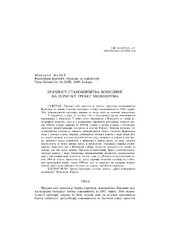Приказ основних података о документу
Bračnost stanovništva Vojvodine na početku trećeg milenijuma
Marital status of the population of Vojvodina at the beginning of the third millennium
| dc.creator | Bobić, Mirjana | |
| dc.date.accessioned | 2021-10-12T10:38:38Z | |
| dc.date.available | 2021-10-12T10:38:38Z | |
| dc.date.issued | 2006 | |
| dc.identifier.issn | 0352-5732 | |
| dc.identifier.uri | http://reff.f.bg.ac.rs/handle/123456789/574 | |
| dc.description.abstract | Predmet ovog priloga je bračna struktura stanovništva Vojvodine na osnovu podataka poslednjeg popisa stanovništva iz 2002. godine. Zbog ograničenosti prostora, analiza se svodi samo na osnovne pokazatelje. U najkraćem, u radu se zastupa teza o blokiranoj drugoj demografskoj tranziciji u Vojvodini. U osvit novog milenijuma u Vojvodini se odvija demografski razvitak, koji je u razvijenim, evropskim regionima, otpočeo krajem 1960-ih godina, odnosno od 1990-ih godina u slučaju država u postsocijalističkoj transformaciji centralne i istočne Evrope. Osnovna obeležja tog demografskog režima su opadanje univerzalnosti braka, odlaganje formiranja unija u kasnije godine širenje raznovrsnih stilova života u paru izvan braka, porast razvoda i opšte nestabilnosti unija, celibata i rađanja izvan braka, povećanje rodne jednakosti u privatnoj i javnoj sferi, uz dalje opadanje fertiliteta do veoma niskih nivoa, i posledično, ubrzavanja starenja stanovništva. Vojvodina, kao i Centralna Srbija, sledi ove trendove ali, sasvim na začelju, iza obe grupe zemalja. Procesi modernizacije braka, deinstitucionalizacije života u paru napuštanje tradicionalnih vrednosti, individualizacija i diverzifikacija životnih tokova, koji su u Vojvodini registrovani tokom 1980-ih godina presečeni su, usled erupcije poznatih događaja na globalnom društvenom planu tokom 1990-ih, što se odrazilo na usporenu konvergenciju ovoga dela zapadnog Balkana ka širem, evropskom okruženju. | sr |
| dc.description.abstract | The topic of this contribution is marital structure of the population of Vojvodina, based on the data from the last census from 2002. Due to the limited space, the analysis is reduced just to the basic indicators of marital structure: the distribution of the population according to the marital status, average age of the population when forming or dissolving unions, celibacy and divorced condition, while the processes of nuptiality and divorce rate, as the dynamic factors in the shaping of the structure, had to be left out. In short, the paper advocates the thesis about the blocked second demographic transition in Vojvodina. On the eve of the new millennium a demographic trend occurring in Vojvodina began in the developed European regions at the end of the1960s, that is in the 1990s in case of Central and Eastern Europe. The basic features of that demographic regime were the decline of marriage universality, postponement of the formation of unions for later years, increase of different life-styles in pairs outside classic marriage, increase in divorce and general instability of unions, increase of celibacy and giving birth outside marriage, increase in gender equality in the private and public sphere, with further decrease in fertility to very low levels and acceleration of the processes of population ageing. In that respect, Vojvodina - as well as Central Serbia - lag behind the developed states of North-West Europe, but also the states in the postsocialist transformation. Modernization of marriage, its deinstitutionalization liberation from the traditional value system, ideological changes which were registered in Vojvodina in 1980s, were discontinued because of the eruption of events on the global social plane, which slowed down the approach of this part of West Balkans to a broader, European environment. | en |
| dc.publisher | Matica srpska, Novi Sad | |
| dc.rights | openAccess | |
| dc.source | Zbornik Matice srpske za društvene nauke | |
| dc.subject | Vojvodina | sr |
| dc.subject | razvod | sr |
| dc.subject | Evropa | sr |
| dc.subject | celibat | sr |
| dc.subject | bračna struktura | sr |
| dc.subject | "druga demografska tranzicija" | sr |
| dc.title | Bračnost stanovništva Vojvodine na početku trećeg milenijuma | sr |
| dc.title | Marital status of the population of Vojvodina at the beginning of the third millennium | en |
| dc.type | article | |
| dc.rights.license | ARR | |
| dc.citation.epage | 323 | |
| dc.citation.issue | 121 | |
| dc.citation.other | (121): 313-323 | |
| dc.citation.spage | 313 | |
| dc.identifier.fulltext | http://reff.f.bg.ac.rs/bitstream/id/2104/571.pdf | |
| dc.identifier.rcub | https://hdl.handle.net/21.15107/rcub_reff_574 | |
| dc.type.version | publishedVersion |

